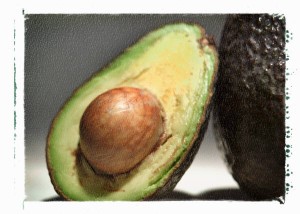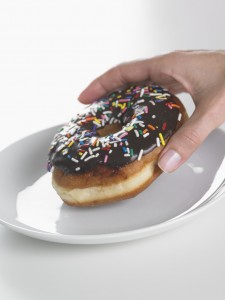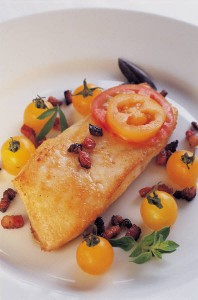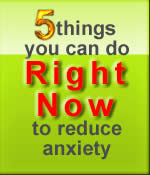Anxiety Therapy with Fast Foods
Fast foods? Say what? I’m not talking about greasy burgers and fries. I mean “on the go” whole and nutritious foods as anxiety therapy.
Nutrition has as a huge impact in how we feel. Our choices can leave us feeling vibrant or anxious and depressed. As the old saying goes, “We are what we eat.” In the past, if I was hungry I would often stop for a fast food salad or sandwich. I thought I was making healthy choices. Little did I know that the dressings and marinades were full of hidden sugar, preservatives, and flavor enhancers. Many chemicals in prepared foods mess up brain chemistry, compounding anxious feelings. As I discovered these things, I would often stop at health food stores for a snack to no avail. Again I found refined carbohydrates and tons of sugar. A label that says, “natural or healthy” most often doesn’t mean so.
Now I hit the road prepared. When I’m going to be gone for a long day, I pack a few snacks that will nourish my body and keep my mind calm. To keep my adrenals and blood sugars happy, I eat a little something every couple of hours.
These are my favorite anxiety busting fast foods:
- Avocados. Good fats, good carbs and nutrient dense. Really yummy with a sprinkle of chipotle pepper and Real Salt!
- Nut Mix. Not your ordinary Plantar’s variety that are loaded with salt and chemicalized oils. I sprout almonds, walnuts, and Brazil nuts using the method I gave in a previous post. I mix the nuts with protein packed and low glycemic Ningxia Wolfberries.
- Smoothie on the Go. In case my blood sugar plummets, I have dry PowerMeal mix in a shaker cup ready so I can just add water. I spruce it up a bit with unrefined stevia and a few drops of therapeutic grade orange oil.
- Apples & Almond Butter. You’ve heard me tout the greatness of this snack in previous posts. It’s satisfies and it’s nutritious!
- Left Overs. If I’ve made something great the night before, I’ll pack in in my mini-cooler lunch box and save it for a meal away from home. I always ensure I have substantial protein along with twice as much vegetables.
- Hummus & Celery. Generally I make my own hummus so I know exactly what’s in it. It’s low glycemic and high in protein. The natural sodium in the celery is terrific for the adrenals. Really yummy with added roasted garlic!
If you have found healthy home-made fast food ideas, please share!
Anxiety Therapy via Hypoglycemia Nutritional Supplementation
 I had a terrific question posed to me, “What type of supplements do you use for hypoglycemia?”. Duh, with all of the posts I’ve done recently on how to eat for blood sugar balance, I forgot to address what I’ve used to remedy the crazy blood sugar swings that gave me panic attacks and anxiety. Be sure to also look at any of my posts on adrenal support. Recovering their health is extremely important blood sugar balance and anxiety therapy.
I had a terrific question posed to me, “What type of supplements do you use for hypoglycemia?”. Duh, with all of the posts I’ve done recently on how to eat for blood sugar balance, I forgot to address what I’ve used to remedy the crazy blood sugar swings that gave me panic attacks and anxiety. Be sure to also look at any of my posts on adrenal support. Recovering their health is extremely important blood sugar balance and anxiety therapy.
As for the correcting insulin resistance and hypoglycemia, I’ve tried just about everything that claimed to balance blood sugar. Many things dropped me too low. So caution: if a product claims to support diabetes (high blood sugar) it does NOT mean it will balance low blood sugar. Some supplements (cinnamon, ocotea, green tea extract) gave me anxiety because it caused my blood sugars went down into the 50’s. So anytime I change my supplementation program I only introduce one new thing at a time, test my sugars frequently, and note how I feel until I’ve determined if it’s working well or not.
Through research and personal experimentation, this is what I’ve found that helps regulate my high / low blood sugar swings:
- Fiber. I get 7 grams of fiber through my Power Meal. I also eat a lot of non-starchy vegetables, so there is more fiber there. But, the one thing my body really loves as a fiber source is … an apple. Very complex and hard to find, right? Every day I have one along with raw almond butter as a meal or snack and my body is happy. Fiber has been well documented to help regulate blood sugar levels.
- Omega 3 fatty acids. These help anxiety, depression, seasonal affective disorder, etc. but as far as blood sugar goes – they are terrific. They help insulin sensitivity as well as cell membrane fluidity. Huh? Helps fix the root problem of hypoglycemia and insulin resistance at the cellular level. Plus, they help perk up my mental attitude. My prefered Omega 3 source is Omega Blue and my doctor recommends about 5 grams a day.
- Reservatrol. This has been shown to support insulin regulation. I get reservatrol from my True Source food based vitamin / mineral. I prefer “food” versus synthetic vitamins.
- Vitamin E. Another thing shown to improve insulin sensitivity. The source that I get my Vitamin E from pairs it up with CoQ-10 – which also has been shown to assist with insulin resistance. I use CoQ-10 from Ortho Molecular Products. It’s available through health practitioners.
- Coriander oil. Historically coriander oil has been used for anxiety and to regulate blood sugar. Makes sense because many times anxiety is caused by blood sugar swings. This has been a LIFE SAVER for regulating my blood sugar levels immediately while all the other nutritionals I take repair the actual problem over time. I ONLY USE THERAPEUTIC GRADE CORIANDER OIL. Stuff from the health food store is cheap and it can be very unsafe. I just rub 3 drops on veins close to the surface, usually on the wrists or neck once or twice a day.
- Herbs. I have played with many herb combinations over the course of the past few years. Some with wild success, other times not. The most success I’ve seen is through Ortho Molecular’s Diaxinol and Amazon Herb’s Metabazon. I do only 1 Diaxinol a day and 2 Metabazon’s with each meal.
The combination of items above is what I used that addresses swinging blood sugar levels in the now as well as cellular repair in the long run. Because of their role in blood sugar balance, I also support my liver and adrenals. I did a report on called Loving the Liver that outlines what works for me. Plus, there’s a recorded training I did called Adrenal Intro Audio that’s accessible HERE.
Anxiety Relief, Blood Sugar, & Dining Out
Eating out is one of my favorite things to do because I love to have fun with trying new foods. I also travel quite a bit, so eating out is often my only option. On the road I will always stop at the local grocery store to stock up on snacks, smoothie ingredients, and water. But how boring is that do to for all meals? BIG TIME BORING! I have a few tricks up my sleeve that have worked well so I can eat on the road and still have anxiety relief.
There is no doubt, eating out exposes me to a lot of temptation. High carbohydrate rich food and drink are the yummiest delights on earth; however they are the worst thing for a hypoglycemic, adrenal fatigued, and anxious person. Every restaurant I go seems to have tempting treats like home made Dutch apple pies, cocktails, triple baked cheesy potatoes, and creamy broccoli soup.
How do I avoid temptation? I DON’T! Of course I have to watch what I eat in order to keep my blood sugar balanced. When I was really, really weak and the panic attacks and anxiety were 24/7, I couldn’t have anything that remotely looked like dessert or starch. But as I rebuilt my adrenals and ate a blood sugar balanced diet, I could have “treats” now and again.
These are my (Jen Crippen) dining out blood sugar balancing for anxiety relief tips:
1. I pick ONE treat for the meal. It’s either the sweet potato, margarita, or flourless chocolate cake. Not two of them, not a bit of each – ONLY ONE.
2. If I plan on picking a treat for dessert, I choose a very heavy fat and protein entree. Some examples: 10 ounce steak with extra steamed broccoli, salmon with grilled vegetables, baked chicken with green beans.
3. To add fat, I usually put butter on steamed non-starchy vegetables. I don’t add more if the veggies already come with olive oil or butter already. Acceptable veggie sides are: zucchini, yellow squash, green beans, spinach, and cauliflower. Not acceptable sides are: potato, corn, white rice, couscous, and pasta of any type. Sides acceptable if they are the one “treat” chosen for the meal: carrots, beets, sweet potato, quinoa, wild rice, squash (butternut, acorn, etc.).
4. I always add a salad with my meal. I order it with no croutons and 99% of the time choose plain oil and vinegar as a dressing. Sometimes I only asked for lemon wedges and dress with that. Most salad dressings are full of hidden sugar, especially Asian and honey mustard types. I also ask the wait staff if I can add avocado and/or egg. More fat and protein!
5. Watch the sauces and marinades! These delicious meal additives are flavorful, but they are full of SUGAR. They are also sources of hidden allergens like soy, corn, and wheat – all of which I choose to avoid. I will ask the wait staff about the ingredients and if I choose them with my order, I have it “on the side”.
6. One of my favorite things are soups. I love them all! Unfortunately I rarely can have them when ordering out. They are thickened with wheat or corn starch. Plus, they have high sugar and low protein. When I get a soup craving, I make it at home.
7. Let’s talk alcoholic drinks. Some people will shun me for even considering the acceptability of having one as a hypoglycemic / insulin resistant person. But reality is, 100% avoidance is not always reality. So, if I choose to have a drink – I will have ONE. My body prefers margaritas, the ‘ol traditional lime ones. No fancy umbrella or tropical drinks for me, WAY to much sugar. I also can do a glass of wine, usually red. Red is typically lower in sugar than white. Because alcohol is so hard on a hypoglycemic and adrenal fatigued body, I have a drink once every few months. I know when I’ve overdone it or chosen the wrong type of drink because the next day I will feel anxious.
8. God put taste buds on our tongue that sense sweet for a reason! To avoid all sweets for the rest of my life isn’t a reality. If I avoid all sweets, over time I will crave them and fall off the wagon in a very damaging way to my body. When I choose dessert as my ONE treat for the meal, I also have a strategy. Fact: all desserts are full of sugar. However, there are a few “better” options. Cheesecake, flan, custard, flourless cake, ice cream, and tapioca pudding are a few I will consider. To lessen the sugar blow, I will share with someone else and just have a few bites.
These are a few of my tips for eating out. It took a lot of experimenting and listening to my body to figure out what worked for me. You’ll have to do the same. Have fun and experiment!
Help Anxiety, Know Glycemic Index & Load
My previous two posts have been on blood sugar balancing to help anxiety.
One thing that has been a great help to me is understanding how glycemic index and load of a food impacts blood sugar levels. Not all carbohydrates are created equal! Glycemic index indicates how fast a carbohydrate will turn into sugar in the body. Glycemic load indicates how the carbohydrate affects the blood sugar over time.
The range for glycemic index is high (70 or more), medium (56 to 69), and low (55 and under). The range for glycemic load is high (20), medium (11 to 19), and low (10 and under). I like to choose carbohydrate foods that are rated low for glycemic index and load. If on the rare occasion I want to eat something that rates high, I will just have a few bites along with a very heavy protein and/or fat meal. A small pancake is irresistible along side of a 4 egg omelette!
A fantastic source for more information along with comprehensive tables for glycemic index and load is David Mendosa’s website. He has been one of the top internet resources for diabetes since 1995. His website is very comprehensive on “all things diabetes”. I thank him greatly for his glycemic index and load information.
All this information felt overwhelming to me at first. The food combining, frequency of meals, and glycemic index & load had my head spinning. But after a while, it became second nature. I looked over the tables on David Mendosa’s website and roughly figured which foods I had to be careful of. Pretty much everything refined, processed, and tastes good. Just kidding!
My next blog post will be about how to manage blood sugar balance while eating out. As you know, it was when my blood sugar was swinging high and low was when I experienced relentless anxiety and panic. Because it’s fun to eat out, I want to share with you how I do it and maintain my sanity! Yes, restaurant food can be anxiety therapy.
Anxiety Help, 15 Tips for Blood Sugar Balance
Last post I shared the general idea of how I eat to balance my blood sugars and help anxiety.
My primary issue at first was insulin resistance. My blood sugars would be high (over 200) and drop as low as 39. As I have worked on healing the adrenal fatigue, now I only experience lows usually in the 50’s. If you’re curious about this, you can find more information about blood sugar levels on the American Diabetes Association’s website.
I did a post a while back on Adrenal Fatigue & Hypoglycemia where I explain how they are tied in together and what I did to recover. As my body got stronger through diet change and nutritional supplementation. However, figuring out how to eat was very challenging with a lot of trial and error. I’m sharing a few of my tips with the intention of sparing much frustration!
Jen Crippen’s 15 Tips:
- Eat every 2 to 3 hours. This helps maintain blood sugar levels. Often just grabbing a little snack like a handful of nuts, cream cheese and celery, or last nights leftovers will do the trick. Small frequent meals are better than a few large ones.
- When enjoying raw nut butters without salt added, I add about 1 tsp of Real Salt to a 16 oz. jar. The flavor will then dance on the taste buds!
- To help the adrenals first thing in the day, add a pinch of Real Salt to a glass of water or protein smoothie. The adrenals need salt which I’ve blogged about in the post Adrenal Fatigue & Low Salt Diets. If I have the almond butter as part of my breakfast.
- Carbohydrates (carbs) include sweet potato, potato, rice, quinoa, pasta, corn, bread, root vegetables, peas, hard squash, fruits, beans, chips, etc.
- Proteins include meats, poultry, eggs, seafood.
- Fats include butter, coconut oil, olive oil, cream, grapeseed oil, avocado oil, bacon grease, etc.
- Combo fat/proteins are cheese, avocados, and nuts.
- Non-starchy (non-carb) vegetables include spinach, lettuce, celery, chard, onions, peppers, asparagus, artichokes, Brussels’s sprouts, cabbage.
- At any meal, I never choose foods that have a higher carbohydrate rating than protein and/or fat. Unless, it’s fiber – it doesn’t impact the blood sugar levels. For example: if a meal has 15 grams of carbohydrates, the protein and/or fat must be total greater than that. Say, 10 grams of protein and 10 grams of fat. This is easiest to calculate in meals where nutritional content is on the labels.
- Another way to gauge carb to fats and protein is by volume. I never allow the size of the carb portion to be larger than any that of the meat or fat. I look at my plate and eyeball it. For example with 1/2 cup of ground beef and 1/2 cup of non-starchy vegetables I would not have more than a 1/2 cups worth of black rice. If I want more rice, I have to eat the same volume of meat and non-starchy veggies too!
- When I get the taste for something bubbly with a zing of taste, I will order sparkling water with a wedge of lime. This is great when I’m out to eat. It’s also handy when weaning off of soda!
- Coffee is one of my favorite things in the world, ever! When I had to cut it out of my diet, I mourned. To replace coffee I drink non-caffeinated tea, Teeccino, or Dandy Blend.
- With desserts, I typically have to make my own due to food allergies to dairy, wheat, corn, and soy. Quick balanced desserts are berries with yogurt, apples with almond butter, or gluten free cherry cobbler with whipped heavy cream. For baking, I recently blogged on Recipe Substitutions to make a recipe blood sugar and food allergy friendly.
- I make all of my meals from scratch because it is less expensive, tastes better, and then I know EXACTLY what’s in it. Prepared foods are full of sugars and common allergens.
- Always have snacks with you when you travel! In my car I keep some trail mix as well as a cup with protein powder that only water needs to be added. In my purse is an apple and nuts. When my blood sugar drops, I am not tempted to stop for fast food.
Hope these 15 tips help! My next post will be on what the glycemic index is. This helps me figure out how a sweet potato versus white rice affects my blood sugar. The most critical step to recovering my sanity was minding what I ate, this is why I’m sharing my secret food tips to help anxiety!












